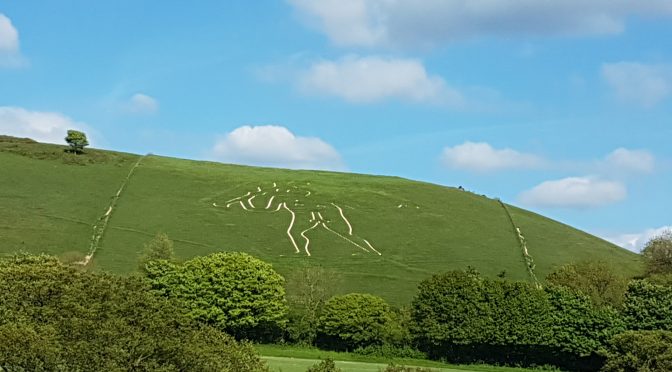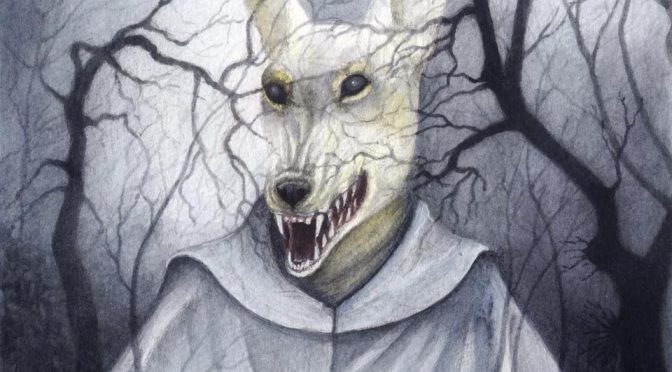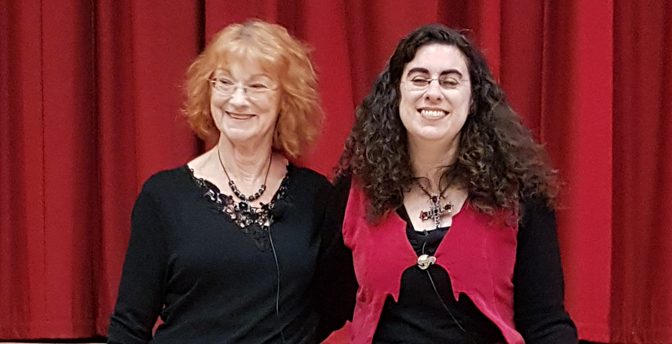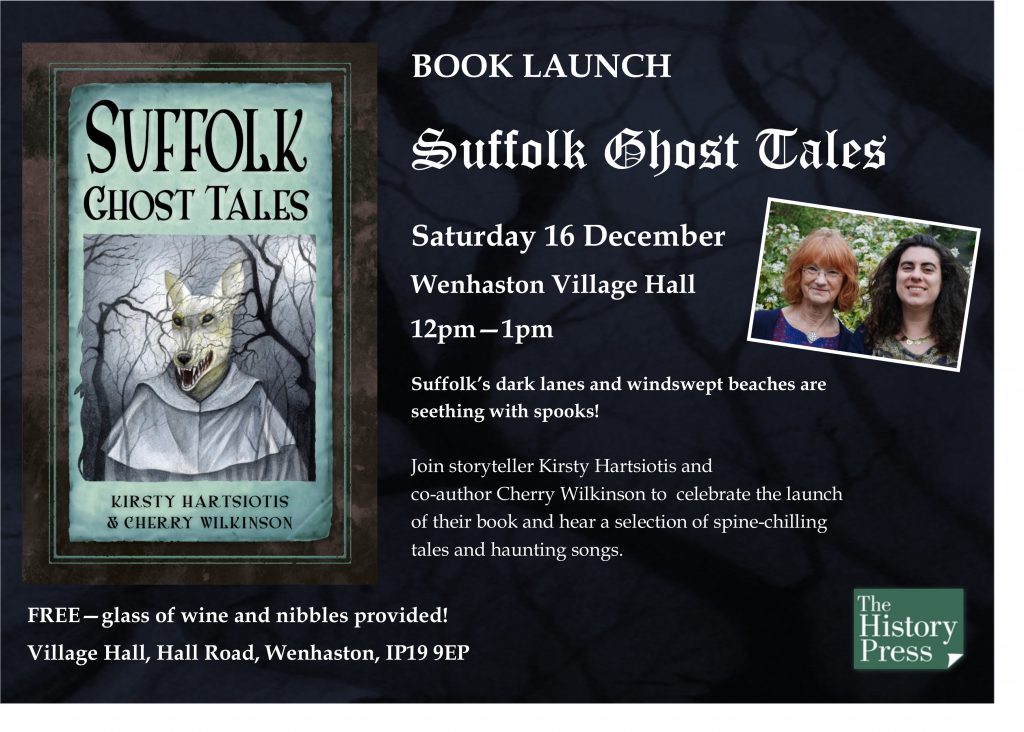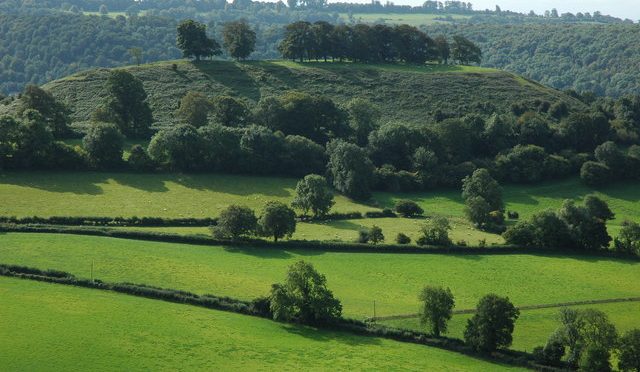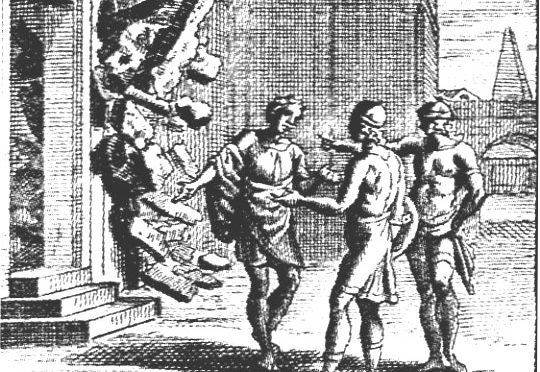Lovely new write up for Suffolk Ghost Tales, with an interview Cherry and I did with Sheena Grant of the East Anglian Daily Times:
Category Archives: Uncategorized
Holiness and profanity? A visit to Cerne Abbas
We all know what to expect from Cerne Abbas, don’t we? A picture speaks a thousand words on this one. Shall I give you a close up? No? We all know that by the 19th century he was associated with fertility and that it’s said that as a woman either sleeping alone in the phallus or, er, doing a bit more than sleeping there with your partner can cure infertility. No surprises there… But there’s another fertility boost in the very same village, and this one was probably the one used in the medieval period, and, perhaps, before.
Why? Well, if you go, as Anthony and I did this last weekend, to see the giant from the viewpoint, the text panel tells you that the Cerne Abbas giant may be one of the three ancient chalk figures of England – made, unlike most of the chalk horses and etc., before the Middle Ages. The others are, of course, the Uffington White Horse, which may be up to 3000 years old, and the Long Man of Wilmington, which, is now considered to be probably a lot newer than previously thought, not Iron Age, but 16th or 17th century – possibly much like the Cerne Abbas giant. Unlike the Uffington horse, which is first mentioned in the 11th century, there are no mentions of the two human figures before the 17th century, Cerne Abbas first appearing in 1694 and Wilmington in 1710. The giant might, in fact, be a bawdy caricature of Oliver Cromwell as Hercules (he once had a cloak as well as a club, now obliterated) put there by Lord Holles, the Lord of the Manor.
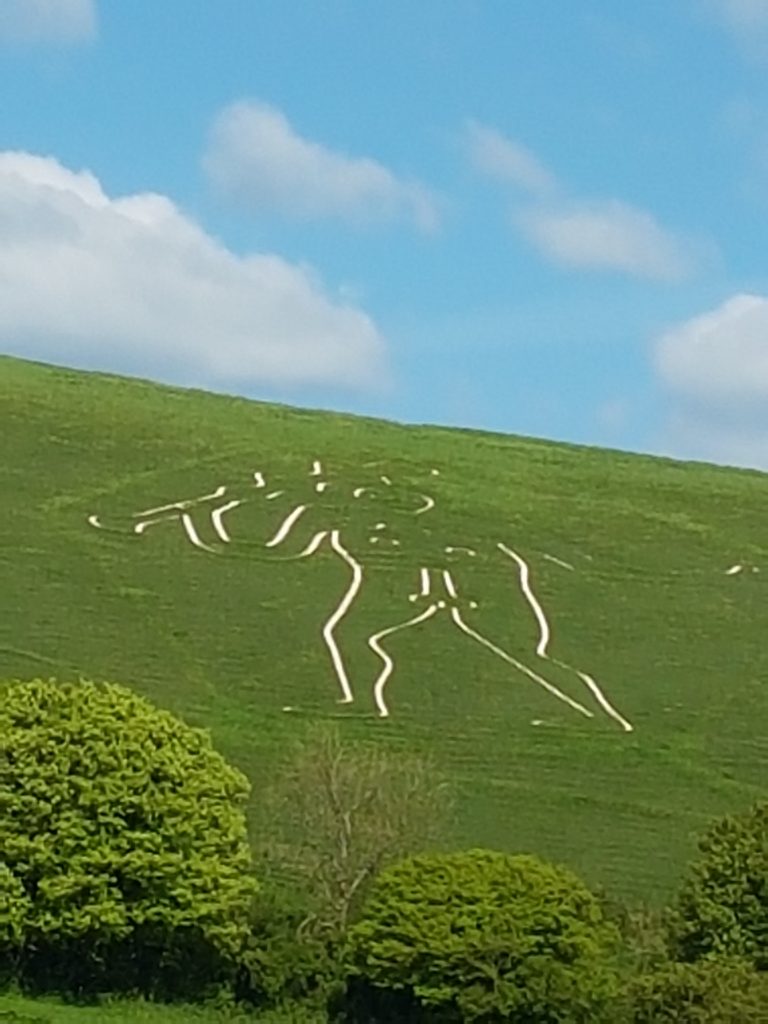
Holles was a Parliamentarian, but a moderate – he hated Cromwell and the army party, and accused him of cowardice. In the complicated times towards the end of the wars, he held fast to his moderate views, begging the king to reconsider. Sadly, neither the king nor Cromwell were moderates, and Holles’ faction was doomed to failure. He was, however, one of the leading people who brought about the Restoration. We will probably never know if he had the giant cut, however, as the first suggestion of this was in the 1770s, nearly a century after his death.
How it was cut and why are lost. If you do get close to it, it’s hard to see how the figure fits together. Anthony walked up the hill, and said that he could just see the horizontals… He didn’t cross the barbed wire into the giant’s enclosure, however. I busied myself with some anthropomorphic flowers instead, the fine Early Purples growing there.
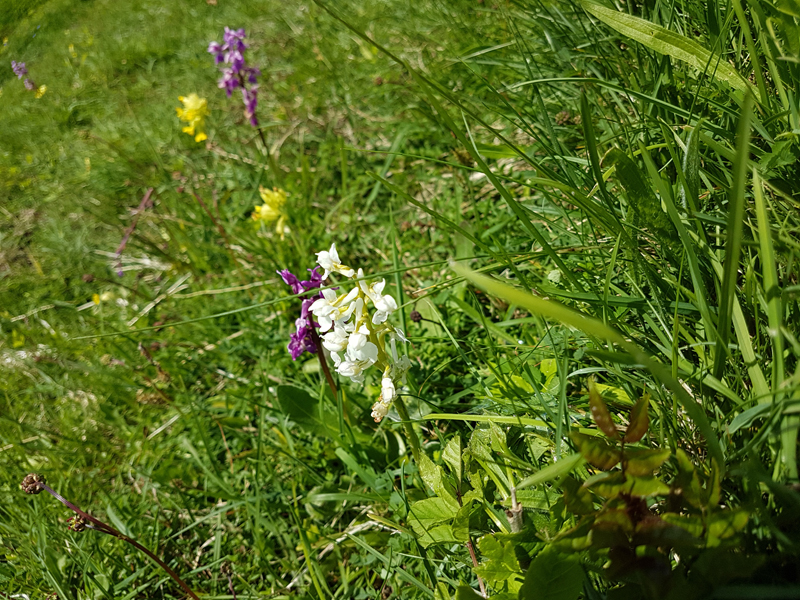
If only they had been Monkey Orchids – much more fitting! (These from a site near Megalopolis on the Peloponnese, though there are a very few sites here in England, there are none recorded in Dorset)

But what about that other fertility place? I had no idea that we were going to get a double folklore whammy from the place when we arrived. Obviously, I knew there had been an abbey there (here’s the site of it – really not a single stone left of the church) but what I didn’t know was the story of its foundation, and why. Indeed, on the OS 1:50000 map, there is no indication that there is an ancient holy well just down from the burial ground of the parish, below where the abbey once lay. It’s there on the 1:25000, but we didn’t have that.
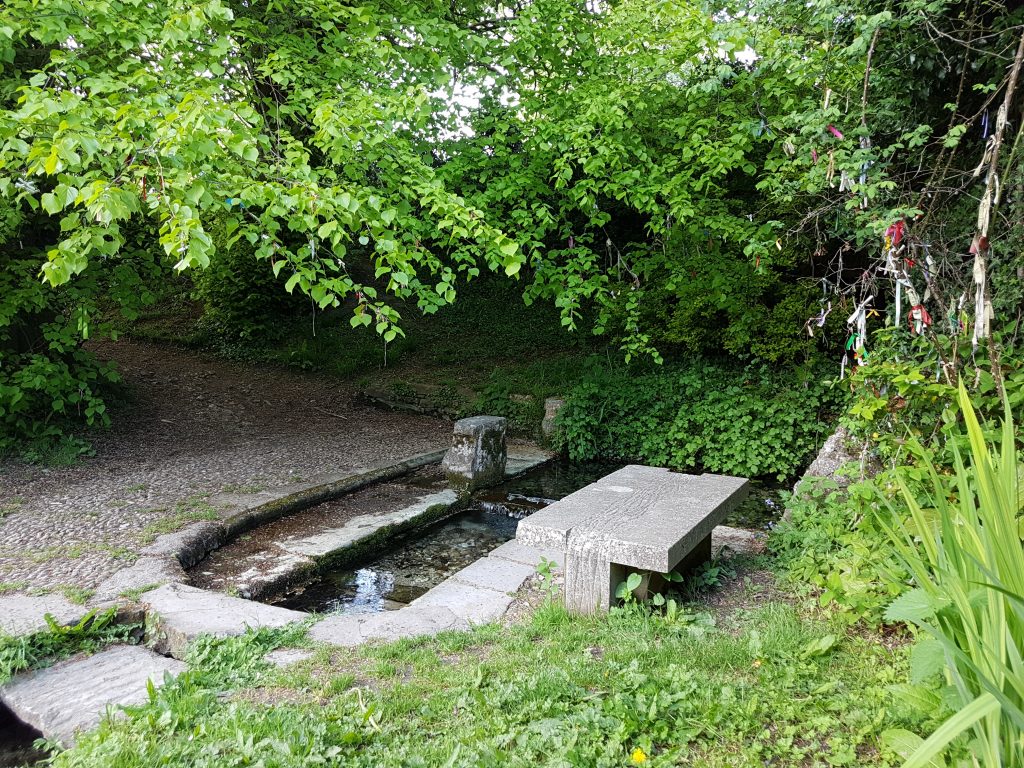
Oddly, there are two conflicting stories as to how the spring was discovered. In the seeming first, it’s St Augustine (of Canterbury, I assume?) who happened to be travelling there. He chanced upon some shepherds, and asked them if they wanted beer or water to drink – and on their saying ‘water’, he struck the ground with his staff and up bubbled a spring. As he struck the ground he cried out ‘Cerno El!’ – ‘I see God!’, a pun on the name of the village, Cernel … thus continuing the great saint punmeister tradition (see St Gregory’s quip ‘non angli, sed angeli’ when seeing English men at a slave market). This, if true, presumably happened at some point in the very early 7th century when Augustine was archbishop.
But, unfortunately, this tale was concocted by the monks of Cerne Abbas in the 11th century. Cruising around the country at that moment was Gotselin, a roving hagiographer – William of Malmesbury says of him, ‘He went over the bishoprics and abbeys for a long time, and gave many places monuments of his surpassing knowledge.’[i] – who happened to be the first hagiographer of Augustine of Canterbury. The first archbishop of Canterbury was a far more exalted founder, the monks evidently thought, than the man who may really have discovered the spring.
The text panel at the well says that the next tale is ‘truth’, but we must be cautious with that – especially as we don’t really know whether this man definitely existed. St Eadwold may – or may not – have a Suffolk connection. He may be the brother of St Edmund, but managed to sensibly skip off out of East Anglia before his brother was killed by the Vikings and make his way to Dorset. On his way, he had a vision of a silver well, and started trying to follow a path to it. On arriving at Cernel he gave a shepherd some pennies – which were, of course, silver in those days – for bread and water, and the shepherd took him to a well. Eadwold recognised it as the one in his vision, and built a hermitage there – though it might not have been at the spring, but on a hill nearby (Giant Hill, anyone?), and he worked many miracles (though I don’t know whether they were before or after he died … O for access to the Journal of Medieval Latin!) He probably died about 900AD, and a swift 70 years later the Benedictine monastery was founded. Of course it’s possible that the well was both struck by Augustine and rediscovered by Eadwold … and used by the shepherds throughout.
But what about that fertility stuff? There are a number cures attributed to the well – it’s good for eyes and newborns as well as curing infertility. It’s also a wishing well, with girls instructed to place their hands on the wishing stone and pray to St Catherine for a husband (there was a St Catherine’s chapel just up the hill). A more sinister superstition is that if you look in the well first thing on Easter Day, then you will see those who will die that year reflected back up at you…
As for chalk figures, even if we don’t have the chalk in Suffolk, we can still do the job… Is the figure of the Suffolk Black dragon still at Bures?
[i] Anon ‘Goscelin or Gotselin, (fl 1099)’, Oxford Dictionary of National Biography: http://www.oxforddnb.com/view/10.1093/odnb/9780192683120.001.0001/odnb-9780192683120-e-11105
Information about the well from the village text panel and from Harte, J M Dorset Holy Wells: http://people.bath.ac.uk/liskmj/living-spring/sourcearchive/fs1/fs1jh1.htm
The Treasure Seekers: finding (or not) gold and wealth in local folklore
If there’s one trope of folklore that appears over and over again, it’s schemes to get rich quick. Jack and the Beanstalk is, of course, one of the most universal – who wouldn’t want a goose that laid golden eggs? Lazy but often kind boys charm princesses into marrying them; pretty and resourceful maids do the same with princes. These fairy tales are a daydream, a wish-fulfilment to those stuck in a seemingly inescapable round of poverty and want. It’s something we can easily recognise in lottery ticket buying and the poring over the lives of celebrities and the royals even as austerity pinches pockets a little further and privatisation erodes the services we once had. But get rich quick stories didn’t always take place in the never-never land of fairy tales. Sometimes they take place right here, in our local area.
In researching the various folk and ghost tale books I’ve written, these tales occur again and again. They are not, of course, tales in which people actually get rich quick. These are the other sort – the sort that tells us not to rock the boat, not to disturb the status quo, to knuckle down and work hard to get your rewards because these schemes always end, if not in disaster, then in disappointment.
You see, there’s treasure hidden out there, under the earth, in ponds, in secret places. We all know it’s true – look at Lance and Andy in Detectorists sweeping their metal detectors over the (allegedly) Essex countryside (actually Suffolk!) and, at the series’ end, discovering the treasure lurking beneath their feet. People have been discovering this hidden treasure for centuries – Roman coin hoards, lost rings, real buried treasure placed with the pagan dead. Even now, we are desperate to concoct tales to tell the story of why this treasure happened to be where it was, even if our tales today tend to be more historically minded than the tales told in ale houses and by firesides in the day’s before we knew the history in the earth. But still, stories they are.

That’s why it’s thrilling to think that the man in Mound 1 at Sutton Hoo might actually be King Raedwald. A real person, attested by that reliable witness, Bede – and in king lists. We already have a story to attach to him. But there is a tale that Edith May Pretty, who owned the estate that the burial ground sits on back in the 1930s, had a friend who saw ghosts there – including one who stood on Mound 1, which, so it’s said, inspired Pretty to get the archaeologists in, just before the Secord World War![i] Of course, there may have long been tales that the burial mounds were haunted – after all, most of them had been ransacked for the treasure that the robbers had failed to find in Mound 1.
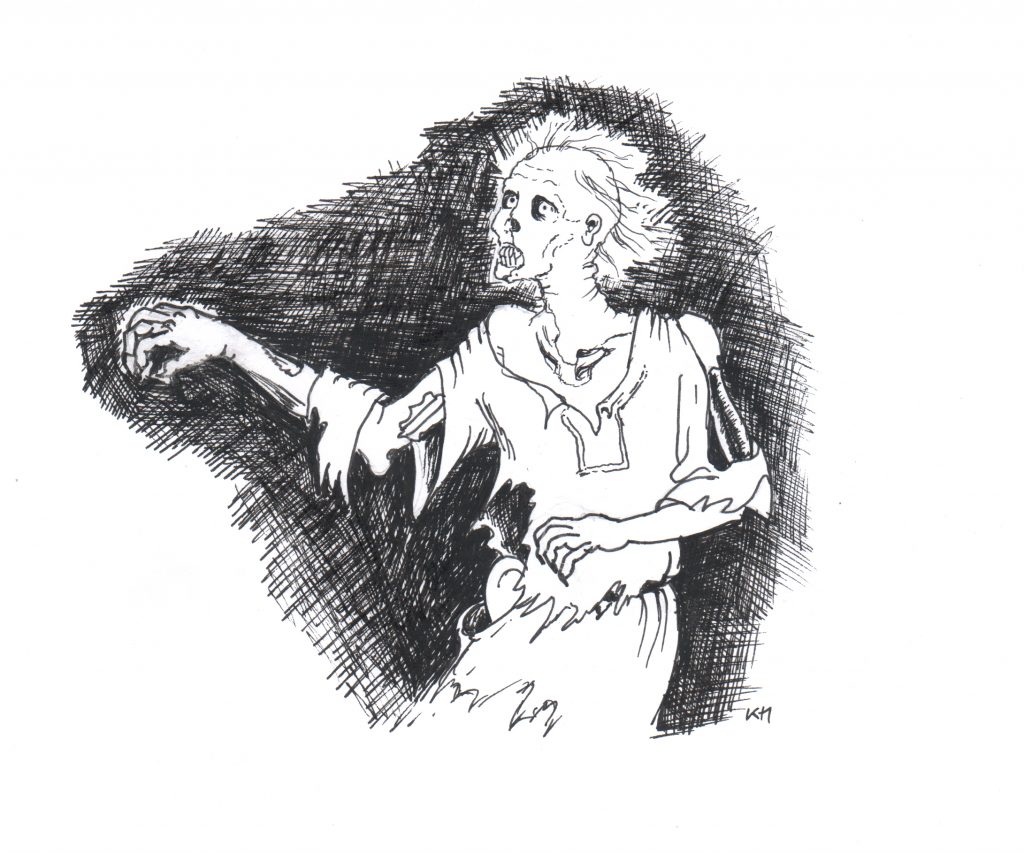
Not surprisingly, burial mounds are often a focus of treasure seeking tales. Not just Anglo Saxon and Bronze Ages ones, potentially likely to hold treasure, but the far older long barrows, which were repositories for bones, not the metal whose use had not yet been discovered by the people who raised them. As I’ve said before, often all these mounds were thought to be Saxon or Viking, so Molly the Dreamer of Minchinhampton can meet a Saxon warrior under Gatcombe Tump long barrow on his dreamed tip off that there’s gold buried there, as retold in Gloucestershire Ghost Tales. But that’s only one example – there’s a Bronze Age round barrow near Bisley, also in Gloucestershire, that’s actually called Money Tump! The tale there, retold by Westwood and Simpson, is that it was well-known that there was treasure there – a farmer wished to bulldoze the mound to find it, saying he’d ‘be rich for the rest of his life.’ [ii] The money came from the chieftain buried there after, presumably, being cut down fleeing the invading Saxons. There have been sightings of headless warriors there, too, though admittedly this was after the Bisley Feast…[iii] There’s a Golden Coffin Field up there, too, at Oakridge, with a tale that the field once contained such a thing – there’s a barrow in the field.[iv]

In Wiltshire there’s a golden coffin, too, but with a darker tale attached to it. It’s associated with one of the barrows on the Down at Bowerchalke, near Salisbury. I tell the tale in Wiltshire Folk Tales, and there are usual admonitions of not speaking while raising the coffin – but of course one of the seekers does, and the seven men who went up the hill to dig up the coffin never came down, but rather roam the hill, dragging the coffin behind them – its theirs for eternity, but not in this life! A tale told to put you off, to deter you from going up the hill and trying your luck! Treasure sits under megaliths, too – such as in Somerset under the wandering Wimblestone[v] – if you can get your hand under there while it’s dancing around the field at full moon and Midsummer’s Eve, or rolling down to meet the nearby Water Stone… What won’t work is yoking horses to it to move it during the day – the Wimblestone mocks you by staying put, then mocks you all the more by telling the tale to the Water Stone when next they meet!
It isn’t just mounds and stones were treasure can be found, back in Suffolk again we find our poster boy, who graces the cover of Suffolk Ghost Tales – the Dog-headed monk (and his nearby fellow, the Monk-headed dog), who is the ultimate odd couple – a monk and dog set to guard a treasure by St Felix, the bringer of Christianity to Suffolk at one of Suffolk’s many Clopton’s that have strangely morphed over the centuries into one being… These creatures are by halls – places of the wealthy, where you might logically think there would be treasure to be found.
Pools are another likely location – makes sense, we love putting treasure in water, a relict of a time in the Bronze Age when we offered sacrificial weapons to the spirits, maybe, of the water, and seen in every penny dropped into fountains around the world to ensure a wish come true or a return visit. At Wimbrell Pond near Long Melford is a sorrowful husk of a ghost who clings to its treasure, calling out, ‘that’s mine,’ when people try to retrieve it – although the pond may be long gone now, and the treasure forgotten. It’s said that there was a major Roman vs Celt battle there, on the Roman road to Coddenham, and that maybe the ghost has been there since then.[vi]
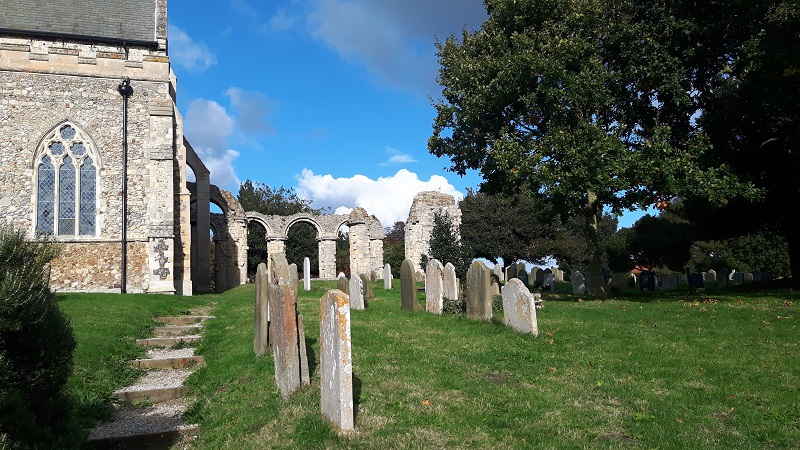
Even if you get the treasure in your hands of a night it will be gone by morning – as evinced by the case of the old lady of Orford who was buried with her gold and sent out of her grave to try to give it away as a punishment for trying to hang onto it when we all knew that, despite what the ancients might have thought, you can’t take it with you. But ghostly gold only exposes the gullibility and avariousness of those who seek it…
What can we draw from all these tales, and the many, many more that I could mention? I don’t know, but I do wonder whether if our society was more equal and wealth distributed so that we were more comfortable, whether we would dream of free wealth in this way and go to the great efforts our folkloric cousins go to get the free thing? Hmm. Back to Lance and Andy again. Much treasure dug up now does go into museums for all of us to see, but what drives the people who seek for it? Are they content with finding the fragments of the past for the thrill of meeting the ancestors? Many are. But – you do get paid the worth of treasure if you find it – divided between the finder and the landowner. And that is a driver as well. And, all of us, we know the excitement of finding a pound coin (not so much a penny, these days, for all the luck it might bring) or more dropped by another…
Images:
1. Cover image for Suffolk Ghost Tales (c) Katherine Soutar-Caddick
2. Sutton Hoo in the snow (c) Kirsty Hartsiotis
3. Wolfhang from Molly the Dreamer (c) Kirsty Hartsiotis
4. The Barrow Thieves (c) Kirsty Hartsiotis
5. Orford churchyard – where the old lady is said to be buried (c) Kirsty Hartsiotis
Notes:
[i] https://www.youtube.com/watch?v=tUG2LqqsEek
[ii] Westwood, J & Simpson, J The Lore of the Land (Penguin Books, 2005), p. 283
[iii] Rhiannon http://www.themodernantiquarian.com/site/4614/money_tump.html
[iv] Grinsell, L V The Ancient Burial Mounds of England (Routledge, 2015), p. 68
[v] Grinsell, L V Folklore of Prehistoric Sites in Britain (David & Charles, 1976), p. 58 & 104
[vi] Burgess, Mike Hidden East Anglia, https://www.hiddenea.com/suffolka.htm#acton
Suffolk Ghost Tales book launch
It’s out! Cherry and I officially launched Suffolk Ghost Tales with a bang on Saturday 16 December in Wenhaston Village Hall – and it was amazing! It felt as if half of East Suffolk came to our book launch party to hear our songs and stories, wish us well, drink fizz and buy the book. The baby’s head has definitely been wetted, and the books are out there now, in the wild…
Here they are before the first sale – alongside a few of my other books! All of the Ghost Tales you see here sold!
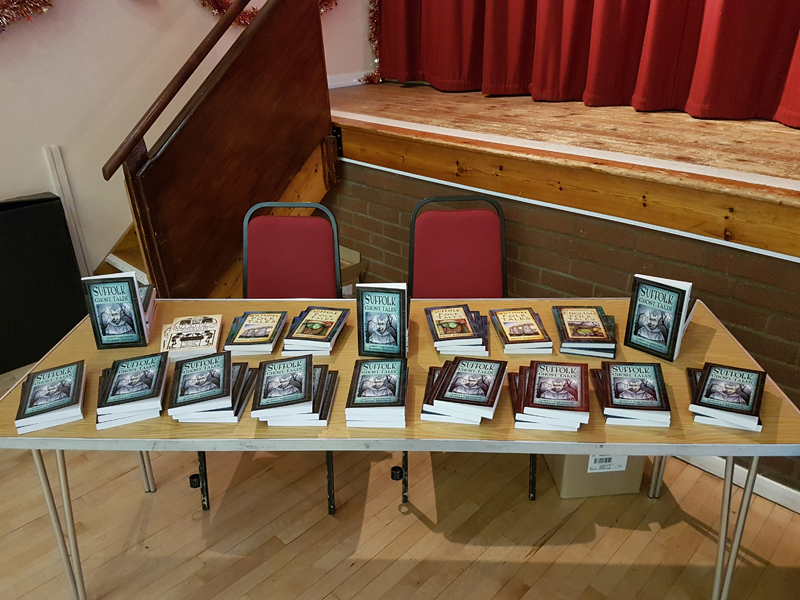
Cherry and I planned a whole performance for the event – storytellers and singers don’t like to do things by halves! I told three stories from the book, and Cherry sang three songs associated with the tales. The first of the stories told was especially for a very special Wenhaston lady, Heather Phillips, to whom the book was dedicated. Heather celebrated her 90th birthday this year, and also published her mother’s memoirs in October also at the village hall. When I was researching Suffolk Folk Tales back in 2012, Heather gave us some silly Suffolk stories from the Saints, which went in the book, but also shared some more spooky tales, which I couldn’t fit in. But they were in our minds when we started on the ghost tales. This time we did include them – and one of the tales tells the story of Heather’s great-grandmother … and father. For all her tales and for her unceasing support and interest – Heather even baked a raft of sausage rolls and Suffolk rusks for the event! – we were delighted to present her with a copy of the book and reveal our dedication:
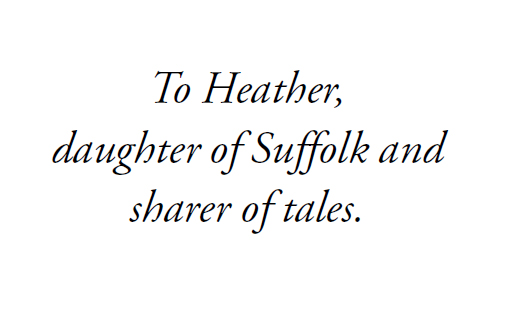
We’re planning a blog about Heather shortly, so watch this space!
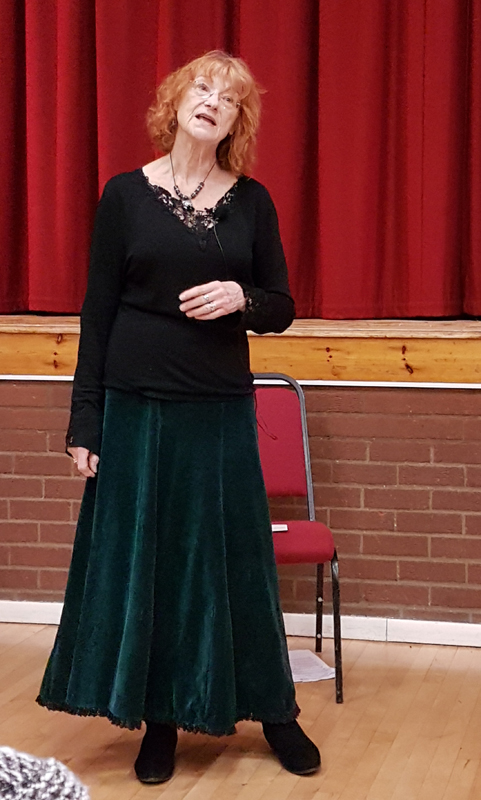
Cherry then sang the song Ranter’s Wharf by John Conolly in homage to the story ‘The Constant Maid’ – this was her first public performance in a long time, and she was perfect! I got quite emotional watching her, as I realised that this was the first time that we had ever performed together – not even when she enrolled me in the Young HADS to be the youngest child in The Admirable Crichton, my first acting performance (first line on stage: ‘What are bunions, Nanny?’), as she did the props, not the acting! I’ll be sharing her songs in future blogs…
I then told another tale of love and loss, ‘Kate’s Parlour’, an eerie place on Jay’s Hill near Sotterley – you can see it here:
Next up was a collaboration – Cherry singing ‘The Cat Came Back’ and the true tale of the 1970s adventures of the mummified cat you can see to this day in The Mill Hotel, Sudbury… It came back…
We finished with Cherry singing ‘The Mistletoe Bough’ a typically Christmas song of … being shut in a ‘living tomb’. Ahem. It’s a story that is associated with lots stately homes in England – in Suffolk, it’s Kentwell Hall in Long Melford.
Then the queue formed and we were signing, signing, signing! Thank you everyone who made the event so special – it was a real community event, with Cherry’s friends and neighbours pulling together to help and make it wonderful for us and our audience.
Especially big thank yous go to the following:
Cherry would like to give a special thank you to Helen Rolfe, her music mentor, for the help with the singing.
Jill and Michael and Janice and Roger for all their help setting up- without whom…
David for his sterling work at the drinks stall!
Viv for being our official photographer – we can’t wait for the images!
Dave for everything along the way, but on the day help with drinks and taking the money…
And for baking the treats people had to eat, Heather for sausage rolls and Suffolk rusks, Felicity for onion tarts and Janice for caraway cake – we were told that everything was lovely, but sadly we didn’t get a chance to sample…
Suffolk Ghost Tales – launch party!
Ooh, the launch of Suffolk Ghost Tales is coming up very fast now! We’re officially launching the book in Cherry’s home village, Wenhaston, near Southwold, on the 16 December – just three days after the book comes (nail-biting stuff!!), so it will be Christmas come early for us! The event’s at 12pm in the Village Hall, and is turning into a real village effort, with help and, most importantly, food being given by Cherry’s friends. There’ll even be proper Suffolk rusks to go with the fizz! And it’s free – although of course there will be copies of the book to tempt – as well as Suffolk Folk Tales and my other books!
I’ll be telling ghostly tales from the book – some local to the Wenhaston area, some not, and Cherry will be singing ghostly songs that relate to the stories and bringing us around to Christmas … that prime ghost story time.
It will be very special to perform alongside her! Cherry, of course, being the person who got me interested in all things folk in the first place. You can find out about how she introduced me to Suffolk’s most famous folk tale, the Green Children, here. Maybe I wasn’t so keen when she and my stepdad dragged me along to folk clubs and festivals as a child, but by the time I was in my early teens I was hooked. I became a storyteller because I couldn’t do what she could – sing – and wanted a way to share the stories I loved. And now we can perform together!
Come and join us if you can – and if not, you can buy the book here. There will be lots more blogs discussing our journey in researching the stories, and discussing the histories behind them here on Palace of Memory, and more events in Suffolk in the New Year – watch this space!
Suffolk Ghost Tales – out very soon!
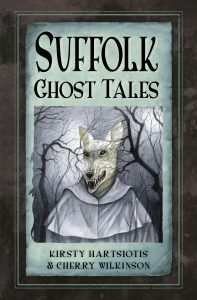 Very exciting news! My new book is out in just a few weeks on the 13 December – Suffolk Ghost Tales, part of The History Press’s ghost tales series. This time, it’s been a really special collaboration – with my mother, Cherry Wilkinson.
Very exciting news! My new book is out in just a few weeks on the 13 December – Suffolk Ghost Tales, part of The History Press’s ghost tales series. This time, it’s been a really special collaboration – with my mother, Cherry Wilkinson.
Here’s the blurb:
SUFFOLK – a peaceful, rural county with big skies, rolling fields, unspoilt beaches, quaint towns and villages. But all is not as quiet as it seems. Could that be the eerie clanking of gibbet chains at the crossroads? Did you see a desolate face at an upper window or a spectral white form lurking in the hedgerow? Cats are not always lucky – and beware a north Suffolk Broad in the still, small hours of Midsummer Night . . .
Kirsty Hartsiotis and Cherry Wilkinson retell, with spine-chilling freshness, thirty fabulous ghost tales from all corners of this beguiling county. So pull up a chair, stoke the fire and prepare to see its gentle landscape in a new light.
Cherry and I moved to Suffolk when I was two, living first near Hadleigh, later in Bury (and a couple of stints over the border in Norfolk, shh). I left, but Cherry still lives in the county, near the coast. Her association goes back long before I was born: her great-aunts who lived in the house next to Lindsey’s little chapel, and through school at St Felix, Southwold and holidays at Sizewell before the power station changed everything… We had a chance to dig more deeply into Suffolk’s heritage a few years ago when I wrote Suffolk Folk Tales (The History Press, 2013).
But there were many places we realised we’d never seen – well, this book has gone a long way to rectifying that. It’s been quite a ride, discovering these wonderful, spooky – often sad, sometimes hair-raising! – stories and working together to create the tales we’ve told. Some you might know well – there’s the story of Toby, the black drummer, and the sad tale of the Lowestoft witches. We’ve travelled all over the county visiting the locations of the tales, talking to the current owners of buildings, and discovering some new stories from people we know.
Suffolk is the ghost county – childhood home of M R James, and the setting for some of his scariest tales. Katherine Soutar‘s wonderful cover illustration hooks into that unheimlich world on the edge of our own… Our tales tread a point somewhere between storytellers’ local legends and the literary ghost story. We hope you will share these stories, too, and keep the tales of the dead alive.
We’re celebrating with a launch event in Wenhaston Village Hall, near Southwold, on the 16 December 12pm. Come and hear tales and songs, and celebrate with a glass of wine!
On Downham Hill … a fairy story for Halloween
It’s the ghost month, October. The month of Halloween and Samhain, when, once again, the veil is thin between this world and the Otherworld of the fairies and the dead. The nights are drawing firmly now, too – at the end of the month, we’ll be changing the clocks and suddenly the evenings will be short. It’s a month for storytelling, for telling tales of that Otherworld. I’ve got a number of gigs coming up in the next few weeks to do just that, and to reveal the hidden places where you might find … something else …
Here’s the science bit: I’m with Anthony at The Wilson in Cheltenham on the 26 Oct, in Stinchcombe Village Hall on my ownsome todd on the 27 Oct, and this Friday 13 I’m in Newent with Anthony, Val Dean and Austin Keenan at the Secret Gallery – more details at the bottom!
One of the tales I’ll be telling is a tale from very close to where we live in Stroud, On Downham Hill, which concerns a certain inn that you might – if you were lucky, if you were unlucky – find up there on a bleak night… I see it a lot, as our cat’s cattery is at the bottom of it! I confess I’ve only been up there once, but fittingly, it was in the snow… Downham Hill is one of the range of hills that lie close to the village of Uley, south of Stroud, north of Dursley. It sits by itself just southwest of Uley Bury with a stand of trees on its flat summit.
This is a storied area. From Downham Hill you can easily see the next hill west, Cam Peak, whose pointed tip derives from the fact that the Devil dumped it there when he was on his way to dam the Severn (because there was, of course, too much God in Gloucestershire), and was foiled by meeting a cobbler with a full pack of worn out shoes to fix. Asked by the Devil how far it was to the river, the cobbler thought fast and told the Devil it was a long, long way – he’d worn out all those shoes just coming from there…
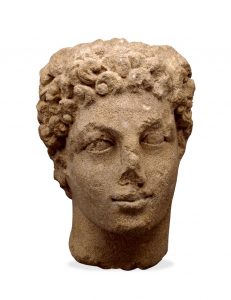 There’s a pair of silver gates buried up on Crawley Hill, somewhere – something to search for on the long roll down to Uley from Stroud. It might be by Money Quarr on West Hill – the site of a Roman complex, including a temple to Mercury[1]. In this case, then, the idea that there might be treasure has been borne out by the finds of statuary – including this head of the cult statue of Mercury – coins, curse tablets and more. But silver gates? Just keep looking, folks!
There’s a pair of silver gates buried up on Crawley Hill, somewhere – something to search for on the long roll down to Uley from Stroud. It might be by Money Quarr on West Hill – the site of a Roman complex, including a temple to Mercury[1]. In this case, then, the idea that there might be treasure has been borne out by the finds of statuary – including this head of the cult statue of Mercury – coins, curse tablets and more. But silver gates? Just keep looking, folks!
And is Cam Long Down actually Camlann, where Arthur and his son, Mordred, fell..?
Downham Hill, however, is a place of fairies. There may be other records of the fey in Uley – was Fiery Lane, the road from Uley down to Owlpen, once Fairy Lane? Roy Palmer suggests so.[2] But Downham Hill, somewhat isolated despite the farms that ring its base, has the reputation of being a place you wouldn’t want to travel to alone. Just the place to find the trickery of the fairies that our protagonist encounters, you might think.
But there’s another explanation for why the villagers kept away. Downham Hill was chosen in the 18th century as the site of a smallpox hospital. It was, apparently, one of the earliest ones, and may have had a link with Dr Jenner, who discovered the vaccination for the disease, and who lived at nearby Berkeley. If it was an isolation hospital, then no wonder the villagers were suspicious – and the hill got the nickname ‘Smallpox Hill’. Added to that is that on the top of the hill is further remains of an older tower-like cottage put up during the reign of Edward III – at around the time of the Black Death[3]. It really is a plaguey hill. Mind you, all the websites are rather vague about both the monument and the hospital, so maybe it’s the fairies after all, warning all us folks away!
Fairy inns are known up and down Britain, and fall into the tale type to do with fairy gifts. Another tale being told on Friday 13th is that of the fairy ointment, where a midwife gets an inadvertent gift from the fairies … until they discover she has it. This tale too shows that the fairies like to give with one hand and take away with the other – as all Harry Potter fans know leprechaun gold turns to leaves after a little time. Probably the best you’re going to get out of it is for everything to stay as it was – but there is a little tale not that far from Uley, from the Wickwar and Wotton-under-Edge area of a ploughman who hears a small, shrill lamentation from by his feet, and when he looks down he sees a tiny little peel (the wooden shovel that bakers (and pizza makers!) use) snapped in two in the dirt. Very carefully, the ploughman picked up the pieces and took it home. That night, he managed to fix it, and the same he took it back and put it where he found it. Later, smelling baking, he followed the smell, and there, in the furrow was left a tiny plum cake – which he ate![4] But perhaps the traveller on Downham Hill was luckier … he got away with his life.
If you’d like to hear this and other stories of the season, here are the gigs:
Friday 13 October Storytelling Evening at the Secret Gallery, Newent, 7pm
Images:
- Downham Hill © Copyright Philip Halling and licensed for reuse under creativecommons.org/licenses/by-sa/2.0
2. Head from a statue of Mercury, 1978,0102.1, AN33834001 © The British Museum
Notes:
1] http://curses.csad.ox.ac.uk/sites/uley-home.shtml
[2] Palmer, Roy The Folklore of Gloucestershire (Westcountry Books, 1994), p. 49
[3] http://cwr.naturalengland.org.uk/default.aspx?Site=5939
[4] Palmer, p. 141
All new blog and the art of memory
It can be tricky, trying to keep all of the balls in the air. My two blogs, Fire Springs Folk Tales and What Would William Morris Say? have been very quiet of recent months. There are only so many hours in the day, after all, and I was working on a new book – Suffolk Ghost Tales, out later this year, co-authored with Cherry Wilkinson – and various other projects (a course to plan, storytelling shows to perform, an exhibition to put on) all converged on the same time and so I was stuck!
So, I’ve decided to change tack and combine my two blogs into one – this one. It looks much the same as the Fire Springs Folk Tales blog – and features one of Katherine Soutar’s wonderful cover designs as the header image, the green girl from Suffolk Folk Tales. It contains all the content from both blogs, so you can still find all the folk tale, storytelling and William Morris related goodies in here, but all together.
I hope you enjoy the new, updated blog!
Those of you familiar with me will see that I’ve given it a title similar to that of my website: Stories from the Palace of Memory. Well, why?
There’s a story about that, of course. Once, a poet called Simonides was declaiming a praise-poem to his host, Scopas of Thessaly, and, as was the custom, he praised a couple of gods as well, Castor and Pollux, the gods of boxing, at which Scopas excelled. Scopas, however, was offended, and when it came time to pay Simonides his fee, he declared that he would give the poet half – and Simonides should ask the gods for the rest!
A little while after, Simonides was asked to go outside, as there were two young men there asking for him. Simonides went, but there was no one there. As he stood there scratching his head, there was a rumbling in the earth and suddenly an earthquake struck, shaking the hall to the ground and crushing all inside. Simonides realised that the two young men must have been Castor and Pollux, and he was grateful, but his role wasn’t over yet. When the rescuers came to clear away the rubble, none of the dinner guests was recognisable, but the poet had memorised everyone’s position in the hall and was thus able to identify who was who.
Simonides, evidently a practical chap, realised that this was a good training for the memory. He developed a memory training exercise from this, using visual locuses as an aid to memory. Poets and orators – and storytellers – have used it to this day.
To me, the past is a palace of wonders, elusive, untrustworthy, perhaps, no matter how objective we try to me … like memory, unreliable, but ultimately nourishing and there to be cherished and preserved as best our fallible human nature can allow.
Fire Springs and Friends events!
Fire Springs are greeting summer icumen in with a song! Ballad Tales is launched in June, featuring stories by editor Kevan, and by Anthony, Chantelle, David, Kirsty and Richard – that’s right, the whole Fire Springs kit and caboodle! You can buy the book here, and why not come to our launch events in Stroud on 9 June and in Bath 19 June?
That’s not the only new book: with his Awen hat on, Anthony is pleased to announce the publication of a new edition of Charlotte Hussey’s Glossing the Spoils – a collection of ‘glosa’ poems casting a contemporary light on passages from medieval epics and romances. Check out the Awen blog for lots of ecobardic content, too!
Two Fire Springs are out next week in Midsomer Norton as part of Bath Festivals – David and Richard are performing Outsiders and Outcasts on 25 May. Four Fire Springs are going to be performing with Gloucestershire goth legends Inkubus Sukkubus at St Briavels Castle for Midsummer – is it a good thing the night is short? Kirsty and Anthony will be telling Gloucestershire ghoulish tales, while Kevan and Chantelle explore the Celtic otherworlds… Further from home, Anthony will be taking part in Writing on the Wall, an immersive day of eco-poetry curated by Jay Ramsay as part of the Waterloo Festival in London, and Chantelle’s performing at Singing Together in Doncaster.
Anthony and Kevan are out and about on the blogosphere, too: On Anthony’s Deep Time blog are new pieces about Greg Bear’s Queen of Angels, Kim Stanley Robinson’s Forty Signs of Rain, W.A. Harbinson’s The Light of Eden, and Austin Tappan Wright’s Islandia. and Kevan’s Bardic Academic page has everything from the Bard of Hawkwood contest to writing fantasy!
Look out for further updates for all spoken word events on twitter @StroudStory and for storytelling on the Gloucestershire Storytelling facebook page and explore the whole bulletin right here:
You’ll want to scroll as there are many, many treats from us and our friends this month!
The Maid, the Maggot and the Saints

On National Dragon Day this year – you might know it better as St George’s Day, the 23 April – two agents from DCHQ (Dragon Conservation Headquarters, not the Other Place) in Cheltenham Agent Green and Agent Krisa will be coming to the Museum in the Park, Stroud, at 3pm to teach dragon tracking and to tell dragon tales straight from the archives – and straight from the dragon’s mouths…
Here’s one of the stranger tales in the archives…
In the small village of Little Langford, on the banks of the River Wylye and on the edge of Grovely Wood, there once lurked a monster. It terrorised the village – it jolly well near destroyed it! But the question is – was it there at all?
The evidence for the tale was self-evident to the villagers. Why, it was carved on the very doorway of their church! There you could see the poor unfortunate maid who thought she’d tamed the beast dressed in her long skirts and there, about to engulf her, are the pointy teeth of the maggot. Carved in the stone below that is a hunting scene, and the villagers said that shows the beast being rounded up by the hunters.

The story is featured in my Wiltshire Folk Tales book, although there are other variants of the legend. Little Langford was one location that had alluded me when I was researching the book. I have to confess – we were put off by utterly torrential rain and spent the day in nearby Salisbury in the cathedral and coffee shops! However, on our way back from the Isle of Wight a week or so ago, we finally went. Little Langford is a very small village, and has been rather compromised by the railway that runs alongside both the road and the river.
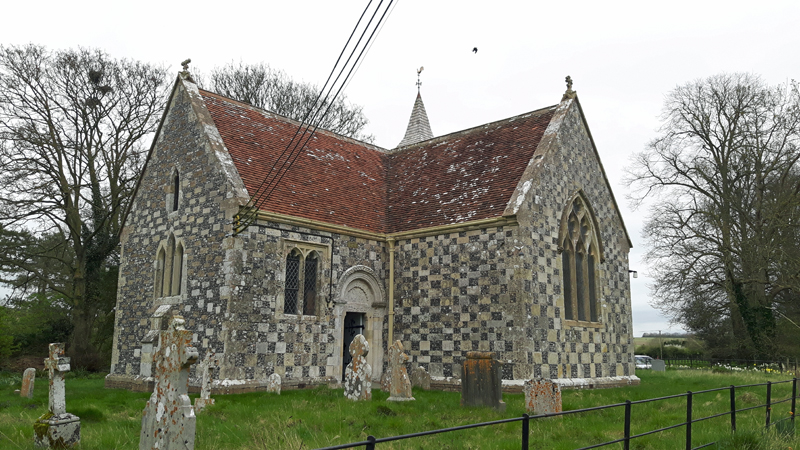
The church is on the other side of the railway to the few houses on the road and, when you get there, appears to be dwarfed by its vicarage. In the church itself we found another version of the tale – this time the maggot, rather than being destructive, did some good in the world. It ate the maid, yes, but she was not an innocent girl but a lady who had wanted to deprive the villagers of their right to gather wood in Grovely Wood.
This wood gathering is a contentious business in the area. In the close by village of Great Wishford, the villagers had to enact a tradition to ensure their rights to gather. The laws concerning this go back at least to Elizabethan times, from when there are charters saying that a group of dancers have to go to the cathedral and be blessed. This used to take place in Whit week, and now – still – happens on May 29, Oak Apple Day. The day begins with collecting the wood – oak no thicker than a man’s arm, green willow and hazel wands – and raising the cry ‘Grovely, Grovely, and all is Grovely!’ All dressed up, the villagers proceed to Salisbury with their banners: ‘Unity is Strength!’, which I presume must go back to the 19th century when it was necessary to fight for these rights. Some branches are placed on the high altar and all is blessed. Then the party begins! So, you can see how excited the villagers might get to have this critical right, the right that gave them warmth through the winter in the firewood they gathered, taken away. But going to the cathedral and dancing is one thing – resorting to a giant maggot is another!
The story echoes many tales of unsuspecting people nurturing something that turns out to be a dragon – or, as they are often called in England, a worm. Now, worms and maggots, it could be argued, are fairly similar in looks, it’s most likely the maggot is really a juvenile dragon. Dragon stories are very rare in Wiltshire, but in next door Somerset there are many…
But is this really what’s going on? The tympanum has other interpretations, and may in fact represent another Wiltshire legend. If you don’t want to hear that it might not be the maggot – stop reading here!
One of Wiltshire’s key saints is St Aldhelm, a 7th century saint who studied at Malmesbury Abbey under the Irish monk Maildubh and at Canterbury, so learning both Roman and Celtic Christianity – he’s also featured in Wiltshire Folk Tales… I like Aldhelm for a particular reason. He was storyteller. Understanding that people can get bored when being preached to, he would liven up his performances with songs, and clowning – even juggling! It was his mission to raise the educational level of Wessex and he wrote songs to help ordinary people understand Christian stories. But there was one time when he couldn’t keep the audience. He was in a place near Warminster, and it wasn’t going well. So he set his staff aside to try some juggling, but then everyone started looking at the staff – it had taken root and flowered!
 There are those that say that the tympanum shows St Aldhelm with his staff now become an ash tree. If you look closely you can see it’s a bishop – there’s his crozier in his hand, his mitre on his head, the correct garments underneath… The carving may have been done around the time of Bishop Osmund of Sarum (1078–1099). Osmund was a particular promoter of Aldhelm’s legend.
There are those that say that the tympanum shows St Aldhelm with his staff now become an ash tree. If you look closely you can see it’s a bishop – there’s his crozier in his hand, his mitre on his head, the correct garments underneath… The carving may have been done around the time of Bishop Osmund of Sarum (1078–1099). Osmund was a particular promoter of Aldhelm’s legend.
But it might also represent St Nicholas, the original Santa Claus, to whom the church is dedicated. You see the three dots in the pattern next to the maid/bishop? Those could represent St Nicholas’ emblem of three balls. BUT – there’s more! For you see, in his youth St Nicholas had an encounter with a dragon – one that marks him as a cuddlier, friendlier saint than our St George. Once, a town was being terrorised by a dragon, and Nicholas was brought in to help. Maybe the town’s folk thought he’d slay the beast, but instead Nicholas charmed it and calmed it so that it troubled the town no more … and they didn’t trouble it. So maybe those sharp zig-zags really are dragon’s teeth and the tympanum shows the moment where the saint calms the dragon down … just in the teeth of time!
If you’d like to hear the story of the Maid and Maggot, of St George and Dragon and more, then join us on Sunday 23 April at the Museum in the Park, Stroud at 3pm. Agent Green is really Chloe of the Midnight Storytellers, and Agent Krisa is me, Kirsty from Fire Springs.
To book simply give the museum a call on 01453 763394. £3 children, accompanying adults go free. And don’t miss out on our special Family Tickets – a steal at just £10!
Sources:
Jordan, Katy The Haunted Landscape: Folklore, Ghosts and Legends of Wiltshire (Cromwell Press, 2000), pp. 20-21
Wiltshire Wandering: Obsessive Journeying to Draw Anglo-Saxon and Norman Sculpture: http://wiltshirewandering.blogspot.co.uk/2017_02_01_archive.html
http://www.information-britain.co.uk/customdetail.php?id=47
http://www.stnicholascenter.org/pages/dragon-charmer/
Images:
All images © Kirsty Hartsiotis

